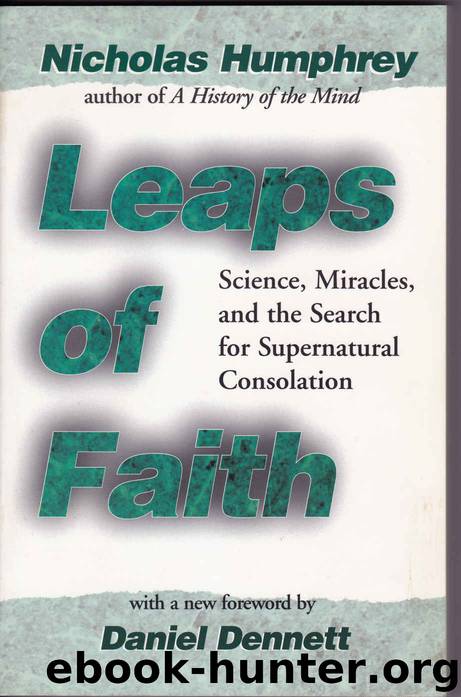Leaps of Faith:Science, Miracles, and the Search for Supernatural Consolation by Nicholas Humphrey

Author:Nicholas Humphrey [Humphrey, Nicholas]
Language: eng
Format: azw3
Published: 2012-08-25T04:00:00+00:00
17
E?S?P?
If we now turn our attention to extrasensory perception, we can apply much the same mix of arguments as we did with PK.
Extrasensory perception can be defined broadly as what happens when someone's mind comes under the influence of distant events without there being the opportunity for observation or communication by any channel known to science. In most cases ESP manifests itself as a change in what the person knows or believes or feels, and it can be assumed that this change is towards the person's becoming aware that the external event is happening. ESP is, therefore, in effect the reverse of PK. With PK, a mental state - a picture of what the subject wishes to happen - creates the distant event that corresponds to this picture. With ESP, a mental state - a picture of what is already happening -gets created by or in response to the distant event.
Cases of ESP are often divided for convenience into two categories, clairvoyance and telepathy. With clairvoyance, the event that the subject becomes aware of is a material fact about the world: as when someone is able to read what is inside a sealed envelope, to visualise that a child is in imminent danger, to describe to a stranger the layout of his sitting room, etc. With telepathy, the event that the subject becomes aware of is the content of another mind: as when someone is able to recognise which playing card another person is looking at, to anticipate that someone is about to call them on the telephone, to feel that an absent loved one is in trouble, etc. The other mind does not, however, have to be that of a living person. It could be the mind of a departed spirit or even a divinity: as, maybe, when someone is able to receive messages from the dead, to undergo regression to an earlier life, to meet his ancestors in a dream, or to hear God speaking to him.
Now, since we shall be looking, as before, for evidence of uncalled-for and unreasonable constraints, we need to know what kinds of limitations on ESP - if any - we might actually expect. And, as a guide, we can start by considering the types of limitation that apply to people's normal powers of sensory perception and communication.
We can note again the three categories of constraint. There are physical constraints: a person may be unable to receive certain kinds of message because the physical signal that carries it never reaches him, or because even if it does he is not equipped with appropriate sense organs to pick it up. There are cognitive constraints: a person may be unable to interpret the message once he has received it because he lacks the information-processing capacity or the interpretative skill required to work out what the signal means. There are volitional - though let's now call them attentional - and emotional constraints: a person may show `perceptual sets' and `perceptual defences' - preferentially tuning into some kinds of message or blocking or tuning out others.
Download
This site does not store any files on its server. We only index and link to content provided by other sites. Please contact the content providers to delete copyright contents if any and email us, we'll remove relevant links or contents immediately.
Animal Frequency by Melissa Alvarez(4395)
Sigil Witchery by Laura Tempest Zakroff(4180)
Real Magic by Dean Radin PhD(4073)
Fingerprints of the Gods by Graham Hancock(3940)
Aleister Crowley: The Biography by Tobias Churton(3586)
Journeys Out of the Body by Robert Monroe(3571)
The Rosicrucians by Christopher McIntosh(3466)
Alchemy and Alchemists by C. J. S. Thompson(3449)
Mysteries by Colin Wilson(3395)
Hitler's Monsters by Eric Kurlander(3268)
The Hatha Yoga Pradipika (Translated) by Svatmarama(3229)
John Dee and the Empire of Angels by Jason Louv(3131)
Wicca: a guide for the solitary practitioner by Scott Cunningham(3127)
Infinite Energy Technologies by Finley Eversole(2939)
Book of Life by Deborah Harkness(2867)
Dark Star Rising by Gary Lachman(2830)
The Book of Lies by Aleister Crowley(2800)
Aliens by Jim Al-Khalili(2787)
To Light a Sacred Flame by Silver RavenWolf(2768)
